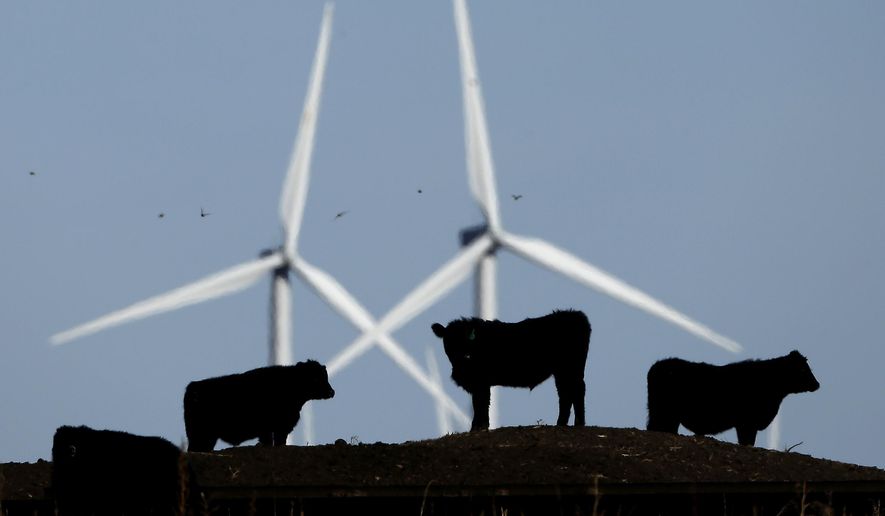Even as President Trump was withdrawing the U.S. from the Paris climate deal, environmentalists — and former President Barack Obama — said it didn’t matter, and the U.S. was locked into a low-emissions future anyway.
With the dust of the decision settling, analysts have taken a closer look and say it’s still possible, though difficult, for the U.S. to meet the goal of the Paris deal even without being a signatory.
Federal data show the U.S. is already well over one-third of its way toward meeting that pledge, with net emissions in 2015 down more than 11 percent compared with 2005. Even without a comprehensive federal strategy to reduce emissions, other factors could continue the downward trend.
State and local governments are undertaking voluntary pollution-reduction measures to make up for the federal pullback. In some cases, they have specifically adopted policies designed to meet the Paris targets. Leading companies also have redoubled their efforts on energy efficiency and are taking other steps to cut pollution.
Perhaps most important, technological developments or massive economic shifts — such as major steps forward on electric cars and renewable energy storage, and the type of market shift over the past 10 years as utilities abandon coal in favor of cleaner natural gas — could propel the U.S. toward its goal.
“Things can change very rapidly. There is the potential for some technological breakthrough making it easier than we think at the moment,” said Kevin Kennedy, deputy director of the U.S. Climate Initiative at the World Resources Institute.
As part of the Paris accord, Mr. Obama committed the U.S. to a 2025 target reduction of 26 percent to 28 percent below 2005 levels. That figure was seen as optimistic under even a best-case scenario that involved federal rules such as the Clean Power Plan, a set of government of regulations limiting carbon emissions from power plants and one that Mr. Trump is rolling back.
What’s clear, analysts say, is that it’s virtually impossible to predict where emissions will go. Even the harshest government policies may not have carried the U.S. to its 26 percent goal.
It’s also entirely possible that the U.S. could hit its target with no help at all from the administration.
Although environmentalists were disheartened by the withdrawal from Paris accord, they say that assuming the emissions goal is now unattainable would be foolish.
“I think it would be unfair to say it’s completely dead,” said Maria Belenky, director of policy and research at Climate Advisers, a policy group that advocates for carbon emissions reductions. “We’re not starting from zero. To hit 26 [percent] is enormously hard, but we’re going from about 12 percent to 26 percent. It’s not easy, but we’re not starting from zero.”
Indeed, data from the Environmental Protection Agency show emissions in 2015 — the last year for which full numbers are available — were roughly 11.5 percent below 2005 levels, meaning the nation is already almost halfway to the 26 percent target. Emissions in 2015 dropped 2.3 percent from the previous year, data show.
A study from the Rhodium Group, a leading research firm, found that emissions from energy consumption — which account for about 80 percent of all greenhouse gas emissions — last year were about 13.7 percent below 2005 levels.
Perhaps more important, they were nearly 18 percent lower than what the federal government forecast in 2008, underscoring the difficulty in predicting trends. The 2008 forecasts didn’t factor in the massive change from coal to natural gas in electricity generation or all of the advances in auto and appliance efficiency, or the rapid growth of wind and solar power.
The Rhodium Group study predicts that even assuming Trump policies stay in place and the federal government does little in the way of carbon-targeting regulations, U.S. emissions could drop by as much as 19 percent by 2025 compared with 2005 levels.
“Renewable electricity costs are tumbling down. Natural gas remains incredibly inexpensive. And there are new technologies that are looking like the wave of the future,” said Ashley Lawson, a senior fellow at the Center for Climate and Energy Solutions. “All of these things are happening, and businesses and consumers are making these choices for economic reasons alone.”
From the administration’s point of view, the fact that emissions could drop without strict government policies bolsters the argument for pulling out of the Paris agreement.
“We have taken significant steps to reduce our CO2 footprint to levels of the pre-1990s,” EPA Administrator Scott Pruitt said this month. “How did we achieve that? Largely because of technology — hydraulic fracturing and horizontal drilling — that has allowed a conversion to natural gas in the generation of electricity. You won’t hear that from the environmental left.”
The lack of federal action on emissions, however, doesn’t mean the government is not making efforts. Dozens of states and cities in the aftermath of the Paris decision have committed to working toward the pledge.
Hawaii, for example, enacted a law this month aligning its own emissions targets with the national goals set out in the Paris accord. Seattle, Philadelphia, Los Angeles and other cities have made similar pledges.
“They’re not stepping back from the challenge,” Mr. Kennedy said. “There’s oddly a sense of momentum being generated to some degree in response to the announcement from the Trump administration.”
• Ben Wolfgang can be reached at bwolfgang@washingtontimes.com.




Please read our comment policy before commenting.